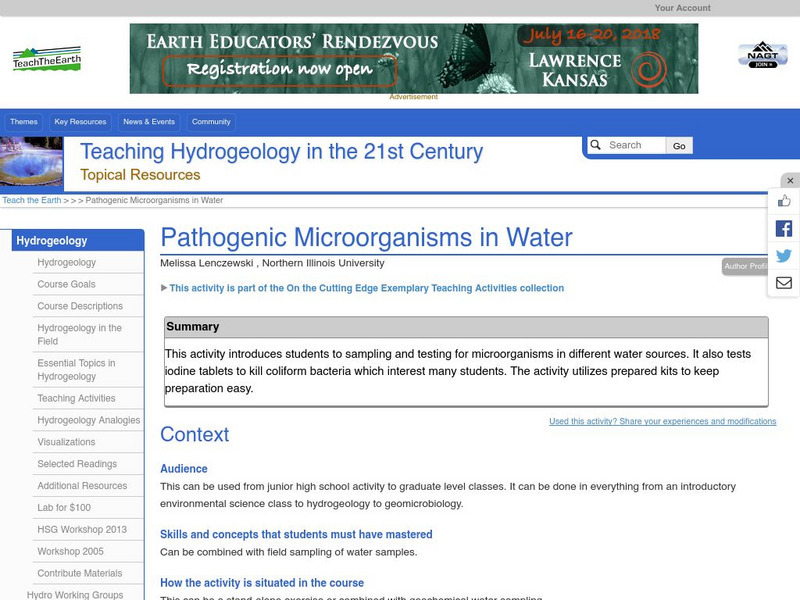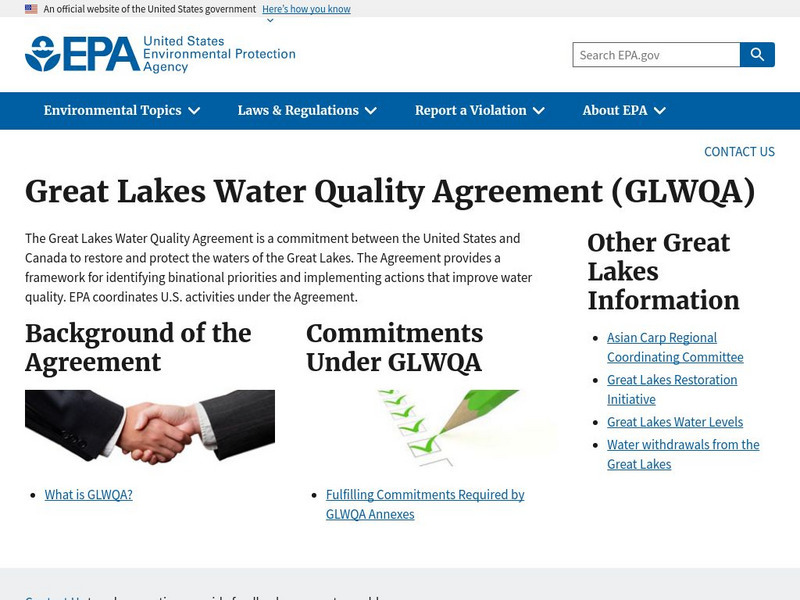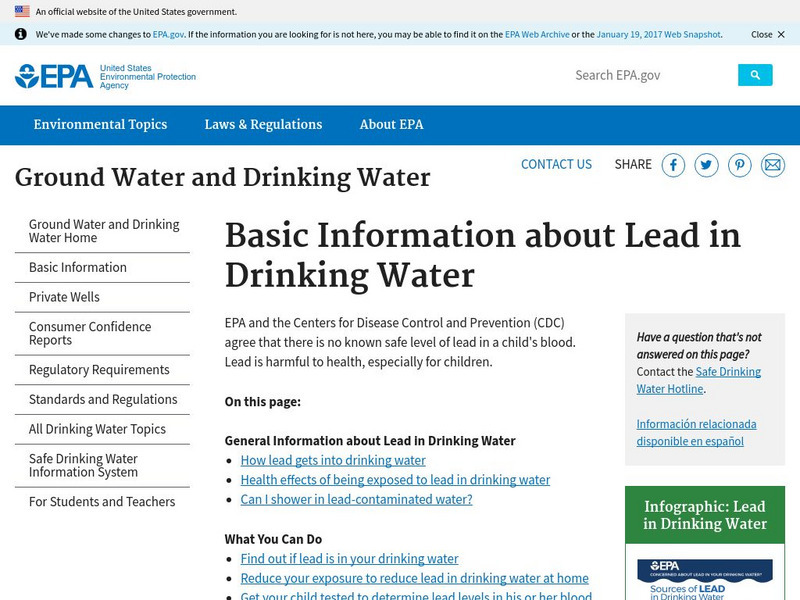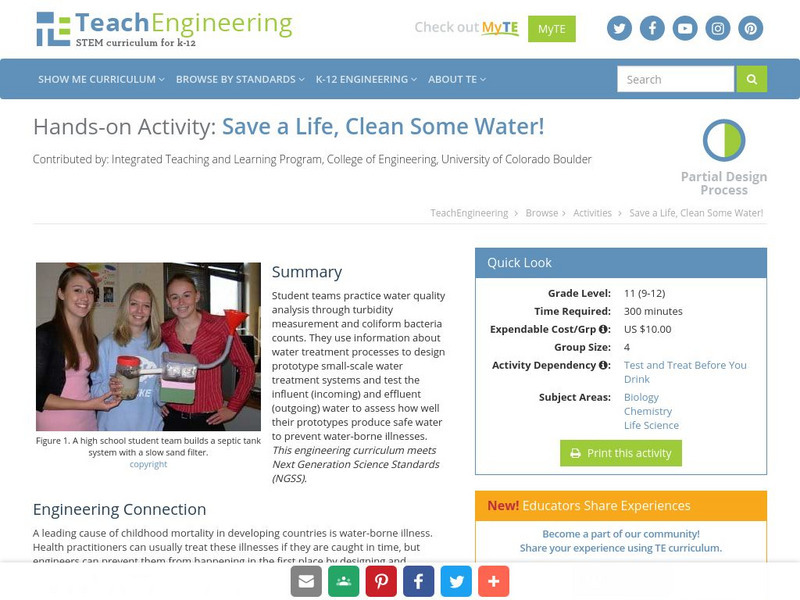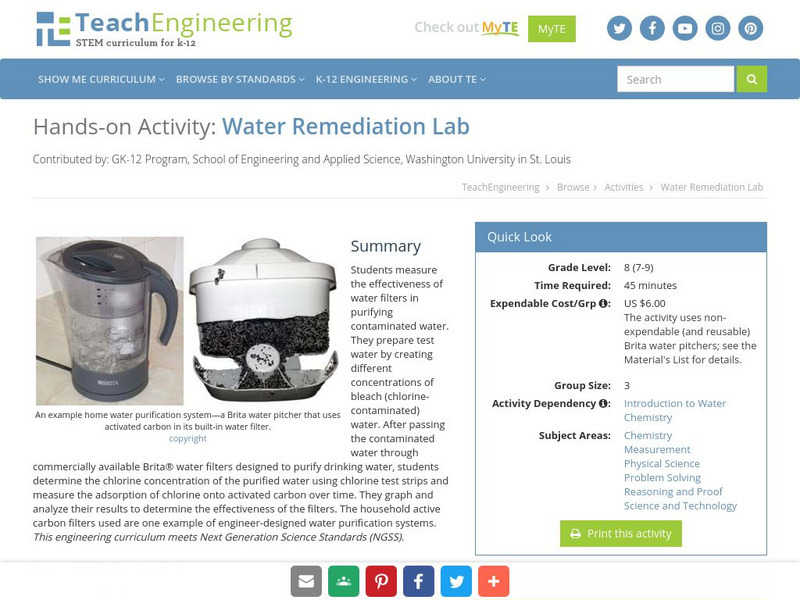Other
Nutrition Action: Water, Water, Everywhere
The Center for Science in the Public Interest offers a discussion of contaminants that can be found in tap water and chemicals added to water in the public water systems. The topics discussed are arsenic, parasites, lead, turbidity, and...
Other
Wet in the City: A Recipe for Clean Water [Pdf]
In this hands-on lesson, middle schoolers will examine the labels on common household products to determine what hazardess chemicals they contain, then test less toxic alternatives to see their affects on water quality. Students will...
Other
Nova Scotia Environment: Iron Bacteria and Sulphur Bacteria [Pdf]
Information page on iron bacteria and sulfur bacteria, both of which can affect the quality of drinking water from a well. Includes guidance on how to recognize their presence, what to do if there is a problem, and how to maintain water...
US Environmental Protection Agency
Epa: Water on Tap: What You Need to Know
Downloadable booklets with basic information about the U.S. water supply, e.g., where our drinking water comes from.
Science Education Resource Center at Carleton College
Serc: Pathogenic Microorganisms in Water
Use this lesson plan to introduce students to testing water sources for pathogenic microorganisms. Students will learn methods for groundwater sampling to evaluate water quality. Lesson plan includes student worksheets.
Georgia Department of Education
Ga Virtual Learning: Ap Environmental Science: Water Pollution and Treatment
Students learn about water management, treatment and purification- global issues that must be addressed to ensure a continued supply of safe water for the growing human population and for the organisms with which we share this planet.
Nature Conservancy
Nature Works Everywhere: How Natural Areas Filter Water
By studying nature's filters, students learn about the importance of water quality for human health and agriculture.[4 min, 6 sec] Includes lesson plan and student handouts.
US Environmental Protection Agency
Epa: Canada: Great Lakes Water Quality Agreement
Information about the quality of water in the Great Lakes and the agreement signed by the United States and Canada in response to problems with the quality of the water.
US Environmental Protection Agency
Epa: Why Are Wetlands Important?
Find out why wetlands provide natural water quality, flood protection, erosion control, recreation and aesthetic appreciation, and natural products.
US Environmental Protection Agency
Epa: Basic Information About Lead in Drinking Water
Learn about the threat of lead in drinking water and what actions you can take to prevent or deal with exposure.
TeachEngineering
Teach Engineering: Can You Catch the Water?
Students construct a three-dimensional model of a water catchment basin using everyday objects to create hills, mountains, valleys and water sources. They experiment to see where rain travels and collects, and survey water pathways to...
TeachEngineering
Teach Engineering: Save a Life, Clean Some Water!
Student teams practice water quality analysis through turbidity measurement and coliform bacteria counts. They use information about water treatment processes to design prototype small-scale water treatment systems and test the influent...
TeachEngineering
Teach Engineering: Would You Drink That?
This activity focuses on getting students to think about bacteria, water quality and water treatment processes. Students develop and test their hypotheses about the "cleanliness" of three water samples prepared by the teacher. Then they...
TeachEngineering
Teach Engineering: Should I Drink That?
Students perform the first steps that environmental engineers do to determine water quality - sampling and analysis. Student teams measure the electrical conductivity of four water samples using teacher-made LED conductivity testers and...
TeachEngineering
Teach Engineering: Natural and Urban "Stormwater" Water Cycle Models
Students apply their understanding of the natural water cycle and the urban stormwater water cycle, as well as the processes involved in both cycles to hypothesize how the flow of water is affected by altering precipitation.
TeachEngineering
Teach Engineering: Does Media Matter? Infiltration Rates and Storage Capacities
Students gain a basic understanding of the properties of media- soil, sand, compost, gravel- and how these materials affect the movement of water (infiltration/percolation) into and below the surface of the ground.
TeachEngineering
Teach Engineering: A Guide to Rain Garden Construction
Student groups create personal rain gardens planted with native species to provide a green infrastructure and low-impact development technology solution for areas with poor drainage that often flood during storm events.
TeachEngineering
Teach Engineering: Water Remediation Lab
Students measure the effectiveness of water filters in purifying contaminated water. They prepare test water by creating different concentrations of bleach (chlorine-contaminated) water. After passing the contaminated water through...
TeachEngineering
Teach Engineering: Environmental Engineering
In this unit, students explore the various roles of environmental engineers, including: environmental cleanup, water quality, groundwater resources, surface water and groundwater flow, water contamination, waste disposal and air...
TeachEngineering
Teach Engineering: Urban Stormwater Management
Through the two lessons in this unit, students are introduced to green infrastructure and low-impact development technologies. Student teams take on the role of stormwater engineers through five associated activities.
TeachEngineering
Teach Engineering: Test and Treat Before You Drink
Students learn about water quality testing and basic water treatment processes and technology options. Biological, physical and chemical treatment processes are addressed, as well as physical and biological water quality testing,...
NOAA
Noaa: Estuaries: Noaa: Science Data: Graphing
Create graphs of marine ecosystems using real-time data.
NASA
Nasa: Exploration: Then and Now: Follow the Water Lesson
The objective of this lesson is for students to learn the location of water and the importance of water to life. Students will learn about osmosis, soil samples, salinity, and more.
NBC
Nbc Learn: Chemistry of Water
This video/lesson series explains how the structure and behavior of H2O in liquid form gives water its properties, and make it a chemical essential for life. Also in this collection: a Victorian-era depiction of the water molecule; news...



![Wet in the City: A Recipe for Clean Water [Pdf] Lesson Plan Wet in the City: A Recipe for Clean Water [Pdf] Lesson Plan](https://d15y2dacu3jp90.cloudfront.net/images/attachment_defaults/resource/large/FPO-knovation.png)
![Nova Scotia Environment: Iron Bacteria and Sulphur Bacteria [Pdf] Website Nova Scotia Environment: Iron Bacteria and Sulphur Bacteria [Pdf] Website](http://content.lessonplanet.com/resources/thumbnails/410103/large/bwluav9tywdpy2symdiwmduymc0xodkwni0xnjd4bw8uanbn.jpg?1589985415)

